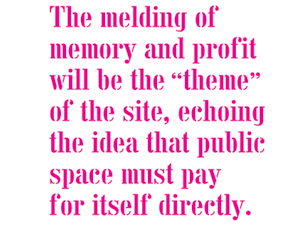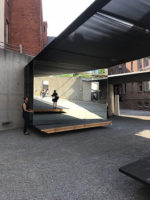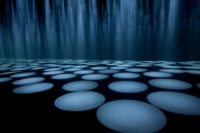GROUND ZERO is a buzzing hive of activity ' cranes and construction everywhere, crowds of tourists and vendors. Projects are shaping up, too. David Childs's One World Trade Center (WTC) ' the erstwhile 'Freedom Tower' ' has passed 78 stories en route to 104, the Fumihiko Maki tower at the southeast corner of the site is more than 30 and heading for 72, and the National September 11 Memorial opens this month.

Although Santiago Calatrava’s bony train station — morphed by budget cuts, according to wags, from bird to stegosaurus — has yet to emerge from the ground, it remains the only piece of architecture with any real ambition on the site. But its price tag — about $3.4 billion — strikes some observers as a tad dear.
The Norman Foster and Richard Rogers towers — two tepid snoozers — are stuck on hold, awaiting word from the market, although the podium of the Rogers tower will be built as a retail “taxpayer.” And Condé Nast has announced it will move its publishing empire and its 5,000 employees to One WTC from Times Square. Those of us in the neighborhood surely look forward to flocks of queuing town cars and many delirious new places for lunch. Anticipating the influx, commercial rentals in the neighborhood are on a dramatic upswing. The two towers under way (by Childs and Maki) will be hyper-bland corporatist products that might have been designed decades ago. Both deploy similar formal strategies, chamfering and carving rectilinear volumes in a wan attempt to burnish imaginative nothingness.
As the two new skyscrapers receive their hermetic skins (some of the dreariest-looking curtain wall in the catalogue) it’s clear that the scale of the complex will be huge and the effect glassy. Because of their load-bearing walls, the original Twin Towers were read as opaque, solid.
The new buildings are shiny, reflective, thin-walled, veneered, and smooth. Their ensemble will be a Monsieur Hulot confusion of mirrors, of uniformity — an infinitely regressive back-and-forth, trying to pick up the reflection of something actually authentic. (Already, Ralph Walker’s beautiful, noble Barclay–Vesey Building of 1926 has been dwarfed by the looming hulks that now butt against it.) This blinding misdirection is the architecture of paranoia. By obliterating their own interiority, by concealing their structures, by an endless gasketing against the foreign gaze (and substance), by laying in a monster infrastructure of surveillance and “security,” this is going to be one very strange and unpleasant place, overscaled and aggressively bereft of humane meaning.
The concealment offered by this nominal transparency has also been pointed up by the announcement that the base of One WTC will not receive the coating of special shimmery prismatic glass originally intended (and on which $10 million had already been spent). This veneer was meant to hide the fact that the building’s massive, 187-foot-high base is designed as a bombproof bunker, a thick concrete redoubt against any future assault. The glass camouflage proved technically beyond its Chinese manufacturer’s ability and so the skin will be more conventional. However, it will presumably still efface the difference between the more vulnerable upper stories (with their actual windows) and their impregnable footing, all in service of an uninterrupted visual ascent up this Everest of bad design and a steady lowering of architectural expectations.
To be sure, we can be grateful that what’s being built has largely been pared of the overwrought semiotics of the original master plan, although its less controversial reinstatement of Greenwich and Fulton Streets remains. The one visible remnant of Daniel Libeskind’s manic cloak of angularity is the little building — by the usually excellent Snøhetta — that will serve primarily as entry for the subterranean memorial museum. Can’t say what it will be like inside, but outside it is shaped and decorated in homage to the otherwise vanished spirit of skew, which the more symmetrical chamfering of the two towers in no way evokes. Along with several extremely obtrusive service structures along the West Side Highway, it seems cruelly placed — smack between the two dignified and apt footprint-fountains. Its relationship to the horizontal serenity of the memorial plaza is carbuncular, disruptive, needless. The mechanicals made us do it!
A controversy that broke out this summer concerns admission to the September 11 Museum, which may not be free and could be as much as 20 bucks. Here’s a small reprise of the crisis at the root of the entire redevelopment, one that garishly represents the nature of the split between public benefit and private aggrandizement. One of the hallmarks of American polity is the increasing pervasiveness of so-called “public-private partnerships” and with them the idea that public space must pay for itself directly, that a park must have a café or a condo in it to cover its costs. At Ground Zero, the melding of memory and profit will, in fact, be the “theme” of the site. As the disproportion between the gigantic exclusionary skyscrapers, the hemmed-in memorial, the pay-to-enter museum, and the upmarket shops in Towers 2, 3, and 4 makes legible, it will be a record of much that is wrong, ungenerous, and crass about American culture today. And I keep wondering when the pious rage that thwarted the proposed Islamic center nearby will turn on the cadre of halal kebab carts that dot the periphery of the site.
As someone who had advocated that the site remain unconstructed, I think wistfully of what might have been, the development that might have been directed elsewhere in the city, the creation of a magnificent and useful civic space, and an expansive act of reverent commemoration. The memorial will surely be noble but it will be overshadowed by too much that is not.



Post a comment to this article
Report Abusive Comment